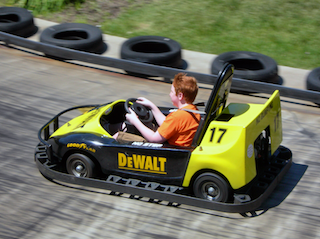If you don’t include speed training into your martial arts practice, you’re making a big mistake. A mistake that could cost you your life.
Wait—what about Tai Chi? They practice slowly. Are you saying millions of students are wasting their time?
Not at all. I practice slowly, too. But I also practice at full speed and with full power. Believe it or not, so do many Tai Chi students.
Why? Because the physical and emotional differences between moving slowly and moving quickly are so vast that you may as well consider them separate activities.
Let me draw a comparison…
My second car was a used Plymouth Sundance. It had a cool black finish, a sunroof, and a turbo engine. Maybe it wasn’t the car of my dreams, but for a 20-year-old guy whose first car was a beat up station wagon, that Sundance was my Batmobile!
Of course, it was just a matter of time before I put the pedal to the metal to see how fast my turbo-charged chariot could go. Two weeks, to be precise.
It was late. I was driving home after Tae Kwon Do class.
The road was dark and empty. I hit the gas.
60… 70… My body tensed.
80… 85… This was faster than I had ever driven before.
90… 100… I stopped breathing.
110… 120… AGHH!
The howling engine and vibrations in the steering wheel were thrilling… and terrifying.
I let up on the gas with a “WHOO!” and the needle dropped to the legal limit.
The lesson was clear—driving at 120 is nothing like driving at 60. Nothing!
My body changed. My breathing changed. My reaction time changed.
The car changed, too. The handling was more sensitive. Fuel burned faster. The engine shook harder.
Let’s take this a step farther…
Imagine you’re a NASCAR driver, hitting speeds of 200 mph. If the difference between 60 and 120 seems frightening, imagine cracking 200!
In martial arts training, when you hit the gas, the same transformation takes place. Pushing yourself to the limits and beyond changes everything—mind, body, and spirit.

That’s why if you practice martial arts without hitting the gas, you’re not even close to being the best you can be. Worse, your favorite self-defense techniques may fail you in a real-life situation.
No, I’m not saying you have to do full contact sparring every class or feed your students cocaine before commanding them to attack you with a knife. Speed training can be a lot simpler and safer than that.
Speed Training Ideas
- Try hitting a heavy bag. I mean, REALLY hitting a heavy bag. Tear it apart.
- Try running through your kata. No, seriously—RUN through your kata. Full speed, full power, no pausing or slow movements.
- Set a timer for 30 seconds. Throw as many kicks as you can. Try again and beat that score.
- Try running down a few flights of stairs like the building is on fire.
- Try chopping up a carrot as fast you can. Careful with that!
- Try doing anything faster than you normally do.
Not so easy! I’ll bet you find yourself off-balance.
I’ll bet your timing is off.
I’ll bet you run out of energy.
I’ll bet you come close to hurting yourself. Or maybe you do!
Why is everything suddenly so difficult… even dangerous? Because unless you make time for speed training, you can’t possibly build up the right habits to do anything well. Not at full speed anyway.
Yet, some martial artists believe their self-defense techniques will work even without practicing them at full speed or with full power. Some martial artists may think they practice at full speed, but never push the limits to really know how much faster they can be.
Either way, if you’re one of those martial artists, here’s a scary thought—
You may have been building poor habits or the wrong habits for years. You may be on the path to becoming an inefficient and ineffective master.
Harsh? Maybe. But here’s the truth—
Standing is not walking. Walking is not jogging. Jogging is not sprinting. Sprinting is not long-jumping. These activities look different, feel different, and require different skills.

To be a master martial artist, you need to examine your techniques from as many angles as possible. Different drills not only reveal different ways to become more efficient and effective, they reveal your current strengths and flaws.
One of the best drills to build good habits and solidify your technique is to simply increase your speed until you fall apart. Unfortunately, many students refuse to push themselves to the point of failure. If they’re grunting and sweating, they figure that’s good enough… but it’s not!
Speed training requires and deserves your full attention. It needs to be practiced on its own.
Enjoy the failure. That’s where the most important lessons are to be found.
The opposite is also true. If you always practice at top speed and full power, challenge yourself to practice every movement as slowly as possible.
This is where Tai Chi excels. Slowing down allows you time to analyze each component of your movement so you can improve your balance, timing, tension, and sensitivity in profound detail.
Slow is great. Fast is great. Slow and fast are the ultimate.
Back to the car talk.
Remember that old station wagon I used to drive? I never gunned its engine to see how fast it could go. I never even considered it because I knew it would fall apart or blow up. In short, I knew what kind of car I was driving.
How about you? What kind of car are you driving? More to the point, what kind of martial artist are you?
Are you an old station wagon? An economy car? A race car? The Batmobile? A rocketship?
Are your techniques built on solid habits or will they break down under stress?
No matter who you are or how hard you train, when you get pushed to your limits, something will fail. Something will break down. The only question is what will it be? And what are you doing about it?
You are only as strong as your weakest link. But if you don’t know what your weakest link is, you’re setting yourself up for an unpleasant surprise when you suddenly need to hit the gas.
Driving a car, a wheel may fly off. Defending your life, you may die.
So, no matter what martial arts style or system you practice, make time for speed training.
Hit the gas and listen for the squeaks and rattles. That’s the only way to keep yourself from crashing.

Ossu! [bow]
This is me: http://www.stationwagon.com/gallery/1970_Chrysler_TownCountry.html
Looks like I need to ramp things up some in my practice time. Class is only twice a week, and I do get pushed, things do fall apart. But I need to push myself, and I thank you for the tips on how to do that!
However… Sometimes things come together better when I go faster. Tonight we were learning a new kick – reverse roundhouse. I had better balance and form when Sensei had us going faster. We always kiai on the tenth count, and on that kick I knocked the mitt off my partner’s hand and clear across the room. I was relieved no end to when my partner said she was unhurt.
[bow]
Osu and HA! Thanks for the station wagon picture! 🙂
Like I said, if you’re working on something at full speed, it’s also beneficial to practice it s-l-o-w-l-y. That’s the whole point of Tai Chi for me. Slowing down gives you time to analyze each component of a movement to ensure that everything is being maximized.
Go try that reverse roundkick in slow motion. What’s the best angle for you knee? When exactly do you pivot? Where’s the weight on your support foot? Which muscles are relaxed and which are tensed? How is your head aligned? How do your arms aid the motion?
Spend the time to go deep into the technique, tweak it, then speed it up to see if it holds up.
BOW!
Osu [bow]
I thought you’d get a kick out of that picture 🙂 Riding in the back of one of those was wicked awesome back in the day, LOL!
My punching bag in the garage is in for some punishment over the holiday weekend 🙂 Thanks!
Have a great Thanksgiving if I don’t “see” you before then!
[bow]
OSU! Happy training and Happy T-Day! I’m certainly thankful for your support! 🙂
Nice article! In my youth I was a stunt driver and have almost always driven an 8 cylinder. Taking curves fast was my favorite! And I know exactly what you mean about holding your breath.
Today… A Prius is about right
Ha! Take that Prius through a shopping mall and you can still have a thrill! 🙂
Guess I need to amp it up a little! Thanks for the reminder! Great topic especially for a teacher like me who doesn’t get a lot of time to practice myself so I really need to make it worthwhile! Thanks, friend!
Andrea! Yup, teaching and practicing are definitely two different animals. Ya gotta feed ’em both…WITH TURKEY AND PIE! 🙂